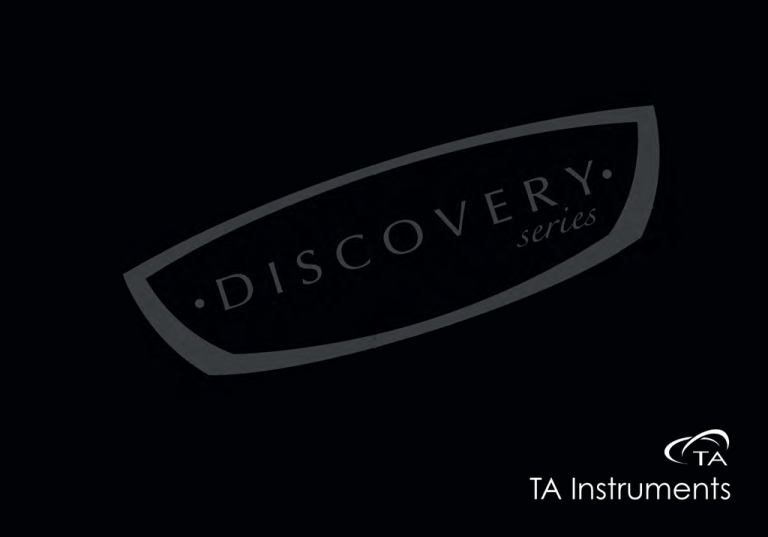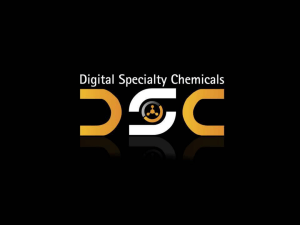
TA Instruments
New Castle, DE USA
Lindon, UT USA
Crawley, United Kingdom
Shanghai, China
Beijing, China
Taipei, Taiwan
Tokyo, Japan
Seoul, Korea
Bangalore, India
Paris, France
Eschborn, Germany
Brussels, Belgium
Etten-Leur, Netherlands
Sollentuna, Sweden
Milano, Italy
Barcelona, Spain
Melbourne, Australia
Mexico City, Mexico
DISCOVER A NEW LEVEL
OF DSC PERFORMANCE
The Discovery DSC
Innovations
Design
Automation
User Interface
Performance
Applications
Specifications
2
4
6
8
10
12
14
18
DISCOVER A
NEW DESIGN
T
he Discovery DSC represents the latest
innovation from TA Instruments. Building
on the Tzero® technology first pioneered in
our Q Series™ instruments, the Discovery DSC
introduces our innovative Diffusion-Bonded
Sensor technology. This technology represents the
future of temperature and heat flow measurements.
The Discovery DSC provides unmatched precision,
accuracy, industry-leading sensitivity and resolution.
The result is a Differential Scanning Calorimeter which
improves every aspect of DSC performance…
The New Discovery DSC
2
3
DISCOVER
THE DIFFUSION-BONDED SENSOR;
THE FUTURE OF TEMPERATURE AND HEAT FLOW MEASUREMENTS
TECHNOLOGY
Diffusion bonding of metals is accomplished by placing two metal
surfaces in contact at an elevated temperature and pressure.
Over time, diffusion of the metals occurs at the atomic level,
producing an intimate, continuous, high-quality bond. In the
Discovery DSC, chromel and constantan are diffusion-bonded
to produce the perfect thermocouple. In the resultant
transducer structure, the diffusion bond is positioned just
below the sample surface, in the perfect position. The
measurement is less sensitive to pan placement effects thereby
maximizing repeatability. Unlike alternative designs which
employ discreet sensor points, the Diffusion-Bonded Sensor
represents a continuous thermosensitive surface, dramatically
improving sensitivity of the temperature measurement while
maintaining a very short time constant for excellent signal
resolution.
*US Patent No. 7,470,057
4
The Discovery DSC
5
THE DISCOVERY DSC
INCLUDES MULTIPLE INNOVATIONS
DESIGNED TO INCREASE PERFORMANCE AND STABILITY
Uniblock Silver Furnace
The Uniblock furnace is precisely machined from a single
block of silver, providing temperature uniformity and ensuring
thermal homogeneity. The result is reduced thermal gradients,
increased ruggedness and improved measurement precision.
Temperature
Controlled Electronics
The Discovery DSC cell processes the measured
signals through an insulated conduit to state-of-theart temperature-controlled electronics, eliminating
the adverse influence of temperature variation
on the electronics which is commonly found in
competitive technology.
6
Diffusion-Bonded Sensor
The heart of the Discovery DSC technology is the Diffusion-Bonded Sensor. To ensure
highly-repeatable and stable measurements, the transducer is precision-mounted on
a fixed pedestal. Unlike competitive designs where sensors are allowed to move,
this pedestal mounting results in a stable configuration with a well-defined heat-flow path
unaffected by thermal gradients. The result is unmatched precision and repeatability of
the heat flow and temperature measurements.
Gas-Delivery Module
Our innovative Gas-Delivery Module is standard on the Discovery DSC. The manifold
design eliminates tubing and hardware connections which are prone to leaks,
ensuring a highly consistent, repeatable inert atmosphere. For experiments which
require dynamic or reactive atmospheres, software-controlled gas switching is also
supported.
The Discovery DSC
7
Reliable Automation
TA’s proprietary autosampler technology* is a
standard feature on every Discovery DSC. Field
proven in thousands of laboratories, the reliable
and easy-to-use autosampler enables customers
to generate superior DSC data around the
clock. Powerful new TRIOS software makes it
easier than ever for users to manage the sample
queue. The re-designed Discovery DSC autolid provides consistent and repeatable cell
closure, providing effective thermal isolation
for the sensor, and further improving
measurement repeatability.
DISCOVER RELIABLE AUTOMATION
AND ENHANCED PRODUCTIVITY
*U.S. Patent No. 6,644,136; 6,652,015;
6,760,679; 6,823,278
8
The Discovery DSC
9
User Interface
DISCOVER
A
REVOLUTIONARY
NEW USER INTERFACE
10
The Discovery DSC redefines the interaction with
the instrument. The large, intuitive display and
interactive menus guide the user to perform
calibrations, control autosampler routines, and
load or unload samples. Simple experiments can
be programmed and initiated through the new
QuickRun menu, and experimental progress can
be monitored with the customizable real-time
signal display.
The Discovery DSC
11
Performance
TA Instruments invented Tzero® Technology, a fundamentally better way to measure heat flow. Tzero Technology provides the
flattest baselines, and highest combined sensitivity and resolution of any DSC available. The Discovery DSC builds on this innovation, and through our latest
advancements provides unmatched precision, repeatability and accuracy of heat flow and temperature measurements, while maintaining our industry-leading
sensitivity and resolution. The result is a DSC which improves every aspect of DSC performance, and delivers meaningful and measurable benefits to the user.
Baseline
The foundation of any analytical measurement is the baseline. A well-designed instrument should contribute very little to the sample measurement, and the
baseline is the fundamental measurement of this contribution. For a DSC baseline, the right answer is “zero”, as any errors in the baseline will propagate
directly to the sample data.
The Discovery DSC technology produces a baseline which is perfectly flat, extremely reproducible, and quantitatively correct. This allows for an unmatched
degree of accuracy for subsequent enthalpy and heat capacity measurements on your samples.
The figure below demonstrate the performance of the Discovery DSC baseline, in linearity, repeatability and accuracy; critical parameters for quantitative
DSC results.
10
Repeatability: ±5 µW
8
6
Heat Flow (µW)
4
2
0
-2
-4
-6
Raw Data, Uncorrected, No Smoothing, No Shifting
-8
-10
-50
0
50
100
150
200
250
300
350
400
Temperature (˚C)
12
The Discovery DSC
13
APPLICATIONS
Sensitivity & Resolution
Resolution
There are countless ways to measure the sensitivity of a DSC, and test methods are often exploited to promote performance under a specific set of conditions. However,
experienced thermal analysts know that the best DSC provides sensitivity under all experimental conditions. The Discovery DSC delivers the highest sensitivity for a
diverse range of heat flow transitions, across a wide range of experimental scanning rates. This is accomplished through the combination of transducer innovations and
our patented Tzero® technology which flattens the baseline, maximizes the signal response and minimizes short-term noise. The result is the highest level of sensitivity
for your materials, under any experimental condition.
Historically, it was challenging to simultaneously optimize both the sensitivity and resolution of a DSC signal. The faster rates required for higher sensitivity degraded
the resolution of the measurement. This limitation is evident in competitive technology, where users are required to choose between a sensor which optimizes sensitivity
versus one which provides higher resolution.
2
-146
16 µW Peak Height
1mg In, 10 ˚C/min N2 purge
0
-147
134
154 154.5 155 155.5 156 156.5 157 157.5 158 158.5 159
Temperature (˚C)
14
229 µg Polystyrene, 5˚C/min
-145
-148
~4 µW Step Change
-149
-150
-151
-2
-4
-6
Q20: 8
Q2000: 60
Discovery DSC: 90
-8
-152
-10
-153
-154
80
85
90
95
100 105 110
Temperature (˚C)
115
120
125
130
-12
150 153 154 155 156 157 158 159 160 161 162 163
Temperature (˚C)
0
Heat Flow (Normalized) (W/g)
17 µg Indium, 1˚C/min
The figure on the left below shows the resolution performance of the Discovery DSC, when quantified using the industry-standard Indium Response Ratio (H/W).
The figure on the right demonstrates a practical application of this high resolution, the analysis of an organic compound at 5°C/min. This sample undergoes solid-state
“lambda” transition followed closely by a melt. The superior performance of the Discovery DSC allows for these two transitions to be easily resolved.
Heat Flow (mW)
154
152
150
148
146
144
142
140
138
136
Heat Flow (µW)
Heat Flow (µW)
The figures below demonstrate the high level of sensitivity inherent in the Discovery DSC, for both subtle peaks (17 μg sample of indium) and step change transitions
such as the 4 μW Tg of a polystyrene sample
The Discovery DSC is designed to simultaneously optimize both sensitivity and resolution. The Diffusion-Bonded transducer optimizes signal quality and sensitivity while
minimizing thermal resistance, reducing the time constant of the measurement. The result is the highest combined sensitivity and resolution available in a DSC today.
-2.0
-4.0
-6.0
-8.0
-10.0
-12.0
-14.0
60
65
70
75
80
Temperature (˚C)
85
90
95
The Discovery DSC
15
DISCOVER EFFORTLESS REPEATABILITY
IN HEAT FLOW MEASUREMENTS
Figure A
22 mg Sapphire Disc, 20 ˚C/min.
Many applications require not only the measurement of accurate heat flow, but also quantitative heat capacity. Heat capacity is the fundamental intrinsic property of a
material which gives rise to heat exchange, and is an incredibly sensitive indicator of structural morphology in a sample. Historically, heat capacity measurements were
performed using a three-run or step-iso method. In addition to the sample measurement, additional runs were necessary to account for baseline artifacts and non-linearity.
Whereas these methods can provide accurate heat capacity, they are laborious and time-consuming.
1.1
-0.25
Literature Cp
1.0
0.9
0.8
-0.3
-0.35
5 runs, Sample removed/replaced between runs
0.6
-0.4
-0.45
-50
The Discovery DSC is free from the baseline artifacts which affect competitive instruments. This quantitatively-accurate baseline provides for the direct measurement of
heat capacity in a single run, without the complications and uncertainty of extraneous events or time-consuming requirements of alternative techniques. This allows
for additional information to be gathered about your sample, in an accurate, repeatable and easy-to-use manner. Figure A illustrates the high level of precision and
accuracy in direct Cp measurements on the Discovery DSC.
0
50
100
150 200 250
Temperature (˚C)
300
350
400
80
Figure B
16
110
120
Temperature (˚C)
130
140
7.3 mg HDPE, 10 ˚C/min
0
-5
-10
Temperature Precision: ±0.005 ˚C
Temperature Repeatability: ±0.025 ˚C
-15
Calorimetric Precision: ±0.04%
Calorimetric Repeatability: ±0.25%
Heat Flow (mW)
-5
-20
145
100
5 mg Indium, 10 ˚C/min.
5
Heat Flow (mW)
Figures B-D demonstrate this level of measurement repeatability on both standard materials as well as real-life samples. In all cases, the sample was removed and
replaced in between each run.
90
Figure D
0
An instrument’s performance is only as good as its repeatability, and scientists demand results with a high level of precision and accuracy. TA Instruments recognizes
this need for precise data and have engineered into the Discovery DSC patented and proprietary technology which provides effortless measurement repeatability.
The combination of the technical innovations results in a level of measurement precision previously unattainable.
Sample removed/replaced between runs
0.7
0.5
Precision and Accuracy
10 Runs, 10.6 mg Polystyrene, 20 ˚C/min
-0.2
Heat Flow (W/g)
Direct Measurement of Heat Capacity
Specific Heat Capacity (J/g ˚C)
1.2
APPLICATIONS
Figure C
Sample removed/replaced between runs
Run #
Onset ˚C Maximum ˚C
1
127.851
131.463
2
127.848
131.467
3
127.873
131.47
4
127.858
131.452
5
127.85
131.42
6
127.866
131.392
7
127.885
131.391
8
127.909
131.387
9
127.914
131.376
10
127.931
131.348
Average 127.879
131.417
δ
0.030
0.044
RSD
-10
-15
-20
-25
150
155
160
165
Temperature (˚C)
170
-30
175
Area J/g
128.401
128.492
128.453
128.501
128.409
128.344
128.485
128.552
128.414
128.588
128.464
0.074
0.06%
-35
80
90
100
110
120
Temperature (˚C)
130
140
150
The Discovery DSC
17
Technical Specifications
Specification
Temperature Range
Temperature Accuracy
Temperature Precision
Enthalpy Precision
Heat Flow Noise (rms)
Instrument Features
Value
-180 – 725 °C
±0.025 °C
±0.005 °C
±0.04%
≤0.08 μW
Baseline Linearity (-50° – 400 °C)
≤5 μW
Baseline Accuracy (-50° – 400 °C)
±20 μW
Baseline Repeatability (-50° – 400 °C)
±5 μW
Technologies
Color Touchscreen User Interface
®
Advanced Tzero Technology
Advanced Modulated DSC
®
Included
Included
Included
Direct Cp Measurement
Included
User Replaceable Cell
Included
50-Position Autosampler
Included
Autolid
Included
Dual Input Gas Delivery Module
Included
Full Range of Cooling Accessories
Available
(RCS90, RCS40, LN2P, FACS, QCA)
Measurement Time Constant
18
≤0.8s
Indium Response Ratio
≥90
Direct Cp Accuracy (-50° – 400 °C)
≤3%
Direct Cp Precision (-50° – 400 °C)
≤1%
Direct Cp Repeatability (-50° – 400 °C)
≤1%
Photocalorimeter
Available
Optical Accessory Kit (Raman, NIR)
Available
Compatible with Q Series™ RCS Systems (RCS90 & RCS40)
Compatible with Tzero® DSC Sample Encapsulation Press
19
tainstruments.com
© 2011 TA Instruments. All rights reserved.
L90012.001



